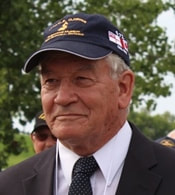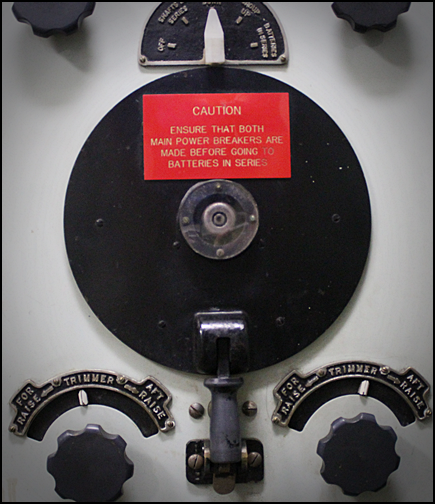|
David Anderson is another former submariner who has been very generous with his time, occasionally doing tours, providing professional input to our Greater Depths tours (three hours on Ojibwa with retired submariners) and by writing articles for the website. He enlisted in the RCN in 1965 and switched to submarines two years later. He earned his dolphins in 1968 and served as a sonarman aboard HMCS Onondaga and HMCS Okanagan until 1973. In this article, Dave takes the mystery out of some of the dials in the motor room.
It's All in the Volts |
It's also all in the Batteries
It bears repeating that it is not the engines that drive OJIBWA forward, it is the motors. The engines charge the batteries that run the motors.
The Main Motor Indicators
|
Here we see the main motors indicators in the "motor room" of HMCS Ojibwa. There are 2 direct current motors turning 2 propeller shafts, one turns clockwise and the other anti-clockwise. Each motor has 2 armatures and in combination with the 2 batteries gives the captain a variety of configurations of electrical powers.
Shafts in SeriesThe lowest setting is "shafts in series". In this setting, only 110 volts are applied to each armature. This is used in 'ultra-quiet' and gives enough speed to maintain depth and course control plus extended battery endurance before needing to 'snort' (snorkeling) to recharge the batteries.
Group Down
"Group down" setting is used to apply 220 volts to each armature. This setting allows reasonable forward speed in transit or for maneuvering while still maintaining significant battery endurance
Group Up
"Group up" setting is used to apply 440 volts to each armature. This setting is used to obtain high speed and normal for surface or 'snorting' transit. As this setting will deplete the electrical charge in the batteries quickly, it is most often used when the engines are running. However, the captain has this option available at any time should the Ojibwa need to escape detection quickly.
Batteries in Series
The highest setting is "batteries in series". In this setting the 2 batteries of 440 volts each are electrically linked to apply 880 volts to each of the 4 armatures. This provides the greatest speed available and is used to put as much distance between Ojibwa and any significant threat in the shortest possible time.
It is also used for some harbour maneuvers where the need to turn the sub in tight radius with one prop turning forward and the other in reverse. In this setting, the batteries will quickly be depleted so judicious use needs to be considered with the operational requirements as the batteries will have to be recharged much sooner. |
The dials in the motor room look alarmingly simple for the second half of the 20th century. However, simple is often silent and that's what is required on a submarine that does 'sneakies'.
To move the white arrow, disengage the handle at the bottom of the black disk and raise it to a position that permits the watch keeper to rotate the disk until it points to the desired position. Very quick and very quiet.
|
Quick Draw! Motor Room Watch Keeper
The motor room watch keeper is able to make changes between 'groups' in only a few seconds so emergency action can take place very quickly if needed.
On the lighter side, read Dave's Day in the Life of a Sonarman


